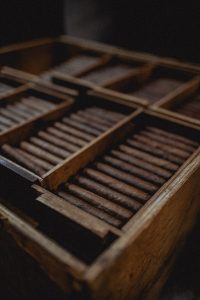Introduction
Quick Navigation
You are a cigar lover, or you consider smoking cigars one of your favourite hobbies for relaxation or fun. But do you know how your cigars are made?. In his article, we will be taking you through the in-depth process involved in making some of your favourite cigars. Most cigars we smoke, are made from tobacco leaves which are wrapped with leaf filling. When compared to cigarette, you will notice that a cigar is longer and thicker in size, which makes you take more time to smoke. But, cigars are one of the best ways for tobacco lover or users to enjoy this product, and they come in different sizes and shapes depending on your preference. The process of making cigars varies between different manufactures, but some basic steps and principles must be followed to get the best quality possible.
Cigars can be handmade or machine-made, no matter how it is made, each cigar has a process which is rigorous that they must undertake in the manufacturing process. This process starts from when the tobacco is planted, to when it is picked, to the sorting of the leaves, to the fermentation process which could take years. After the fermentation process, then the tobacco will be ready to be rolled into cigars. In this process of rolling the tobacco into cigars, the leaves are sorted and divided into three sections which include;
Filler
Binder
Wrapper
Once you can sort the leaves into the sections mentioned above, then it is packaged and sent out to where it will be rolled. Once they arrive at where they are to be rolled, the leaves are inspected again before commencing anything. Next, the filler leaves are joined inside the binder leaf, and then the cigar which has been partially made is wrapped with the wrapper. The final step includes the packaging process, which is one section that is very different depending on the manufacturer. In the packaging process, some cigars are wrapped in and put in a box where it is shipped and sold off just like that, while others are wrapped and packaged alone, and will be sold as a single piece.
Cigar design
With the many different manufactures and their unique way of designing their cigars, it has become very evident that there are different sizes and shapes of cigars available that you could find the one that suits your needs. The shape of a standard cigar is a round head and a parallel side, while cigars which have pointed heads and tapering sides are called perfectos in the cigar world. In the case of figurados, they usually have their special shape and sharpener tapers.
Usually, cigars were rolled by hand, but since the start of the 20th century, that whole process has evolved. The advent of mechanized process of cigar rolling in early 1900, made the cigar output improve tremendously, and that affected the handmade factories, and most of them had to close up. Although, it was noticed that when compared together, the best cigars were usually the ones rolled by hand. But, in today’s market, most of the cigars available are made from machines.
Materials used in making cigars
A complete leaf of the tobacco plant is mainly responsible for the raw cigar material. Although the cigar plant is capable of growing in various climatic conditions, it is a known fact that the best tobacco plants/leaves come from Cuba, Jamaica and the Dominican Republic. Cigar as raw material makes use of three different kinds of tobacco leaves because the smaller or broken leaves are kept separately to be used as fillers. The binders which are usually used inside wrapper are gotten from large whole leaves. Most times, it is common to notice that the binders are imperfect or are made of lower quality leaves, that is because not much attention is paid to the appearance of the binders. But, for the outside wrapper of the cigar, a leaf which is uniform and fine is used for the outside wrapping. Most of the best cigars have the outside and inside wrapped with the same tobacco leaves, while others have their outside wrapped with high-quality tobacco leaves but the inside consist of low-quality leaves and vice-versa.
Manufacturing process
In the manufacturing process, the first thing to do is, to begin with, the tobacco. The process involves seeding the tobacco before they are transplanted into a field where it will be left for a period of about a maximum of two months. While the tobacco is left on the field, it is covered with a cloth to prevent sunlight from doing any damage to the leaves. It could take a while for this plant to finally mature.
Tobacco curing
Before the leaves of the tobacco are cured, they must be harvested first. The curing process is responsible for the special/unique aroma that each cigar possesses. For beginners, you might be wondering what the right time to cure the leaves is, well the curing should occur when the leaves have changed from bright green to brown or sometimes yellowish. The chemical content of the leave, which is chlorophyll will be gradually broken down until it is replaced with carotene. Laths are often used during the curing process of the leaves, and the laths consist of a narrow strip of wood.
Fermentation
The fermentation process if the next step in line after the leaves have been cured, and they are sorted out based on their colour and sizes. In this process, the filler binder and wrapper are gotten. The smaller leaves will be used as the filler, large leaves will serve as the binder, while the ones which are uniform and beautiful will be used as the wrapper.
Rolling
Cigar rolling is a unique skill that usually takes years to acquire, and it is a known fact that the best quality cigars available right now are the ones that are rolled by hand. At the same time, there is also the machine method of rolling a cigar, which the faster and more efficient method of rolling a cigar. However, the cigar method does not produce high-quality cigars like the ones that are rolled with hand.
Conclusion
We are sure after you have gone through this article, you have a good idea of how cigars are made, and hopefully, you will value how much time and effort is put into making your favourite cigar. No matter the kind of rolling process that is used, each cigar goes through a strict quality control procedure at every step involved in the manufacturing process. All the guides and steps put in place are to ensure that you always have the best quality of cigar on offer.

